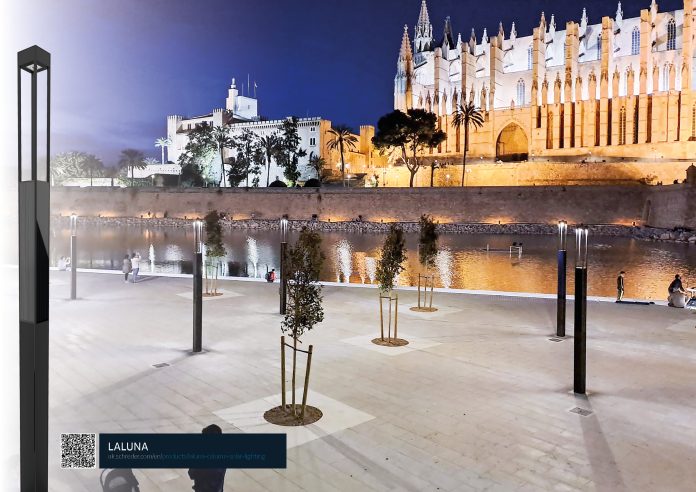Craig Wood from Urbis Schréder outlines the benefits of solar lighting for public spaces, highlighting its role in creating safer, sustainable, and cost-effective urban environments
Towns and cities worldwide face increasing pressure to create safer, more sustainable, and cost-efficient public spaces while working towards net-zero goals. Local authorities must balance the need for reliable illumination with financial constraints, environmental considerations, and the expectations of residents. As energy costs rise and urban areas expand, solar-powered lighting offers a practical, off-grid solution that enhances public spaces without adding strain to local infrastructure or budgets.
Sustainability at the core
At Urbis Schréder, sustainability isn’t just an add-on; it’s at the heart of every solution we create. Our solar lighting technology allows local authorities to reduce energy reliance, cut carbon emissions, and improve public spaces without the need for costly underground cabling or grid connections. By integrating renewable energy into urban lighting strategies, councils can achieve long-term environmental and financial savings while ensuring well-lit, accessible, and inviting spaces.
Investing in solar lighting means more than just meeting sustainability targets; it demonstrates a commitment to innovation, responsible urban development, and future-proofing public infrastructure. With increasing government and environmental pressures to reduce carbon footprints, switching to solar can play a crucial role in decarbonisation strategies while improving public safety and accessibility.

Smart lighting without compromise
For over a century, Schréder has supported local governments in delivering reliable, energy-efficient lighting for streets, parks, footpaths, and civic spaces. Now, they are pushing the boundaries of solar technology, providing off-grid lighting that balances performance, safety, and design integrity.
Through Schreder’s collaboration with Photinus, they bring a new generation of high-performance solar luminaires, perfect for applications such as pedestrian zones and cycle paths – improving safety without expensive infrastructure upgrades; parks and recreation areas – providing sustainable illumination to enhance community spaces; heritage sites and landmarks – reserving aesthetics while meeting sustainability commitments; car parks and remote areas – ensuring reliable lighting where grid access is limited; and housing developments – offering a cost-effective alternative to traditional street lighting.
Unlocking the benefits of solar
Modern solar lighting offers a resilient, cost-effective solution for public spaces. With no need for a grid connection, it’s ideal for off-grid locations or retrofitting, cutting both infrastructure costs and energy bills. Schréder’s advanced battery management system lasts up to 12 years, while durable solar panels last 30 years with minimal efficiency loss. Intelligent lighting controls, including adaptive dimming and motion detection, further enhance efficiency and safety.
By reducing reliance on fossil fuels, solar lighting helps lower carbon footprints, supports local climate action plans, and aligns with government sustainability targets, all while delivering high-quality illumination for communities. Additionally, solar solutions help councils avoid potential grid connection delays, providing an efficient and cost-effective way to enhance public spaces without the need for disruptive infrastructure projects.
Smarter public lighting with EXEDRA
For councils looking to integrate a control element, Schréder’s EXEDRA offers a future-proof smart lighting platform that enhances safety, efficiency, and sustainability. With EXEDRA, councils can remotely monitor and manage their lighting assets, optimising energy use and adapting to real-time conditions.
The system dynamically adjusts lighting levels based on footfall, brightens when movement is detected, and dims or turns off in low-traffic areas to minimise unnecessary energy consumption.
It also enables event-based lighting control, allowing civic landmarks to be illuminated for special occasions while seamlessly integrating with broader urban planning strategies. By ensuring lighting is only used when and where it is needed, Schréder’s EXEDRA helps councils achieve cost savings, reduce light pollution, and support dark-sky initiatives.
Funding opportunities for solar lighting
Many local authorities may be concerned about the initial investment required for solar lighting projects. However, several funding opportunities and grants are available to support sustainable infrastructure initiatives. Councils investing in renewable energy solutions can access government-backed funding schemes aimed at promoting energy efficiency and reducing carbon footprints. Additionally, the long-term savings associated with solar –including reduced electricity costs and lower maintenance expenses – mean that the return on investment is significant over time.
By taking advantage of these funding opportunities, councils can implement cost-effective, environmentally responsible lighting solutions that benefit both residents and local budgets.
Book your solar CPD today
Urbis Schréder invites you to explore how solar lighting can transform public spaces while contributing to decarbonisation targets. Their Solar CPD session, led by industry experts, provides valuable insights into the potential of solar-powered lighting, answering key questions and equipping councils with the knowledge to integrate sustainable solutions effectively.
By booking your CPD, you’ll gain:
- In-depth knowledge of how solar lighting supports sustainability and cost reduction.
- Real-world case studies from councils and public sector projects.
- Practical guidance on integrating solar lighting into urban planning and development.
Ready to explore solar lighting for your community? Book your CPD today and contact us at sales@urbis-schreder.com

This work is licensed under Creative Commons Attribution-NonCommercial-NoDerivatives 4.0 International.











